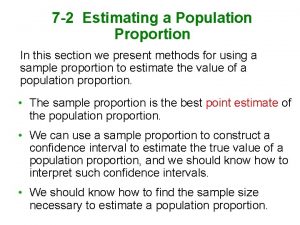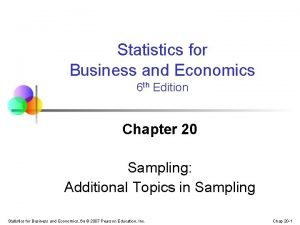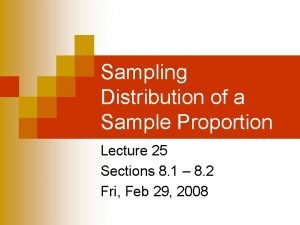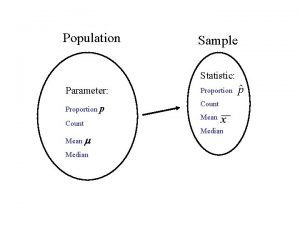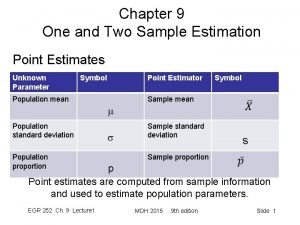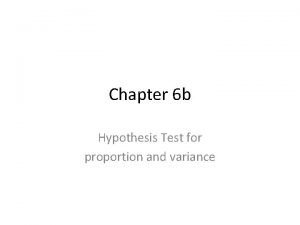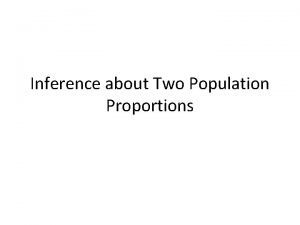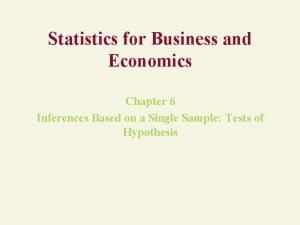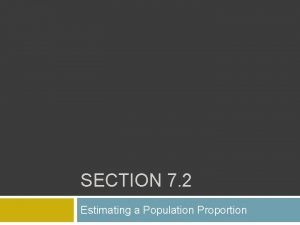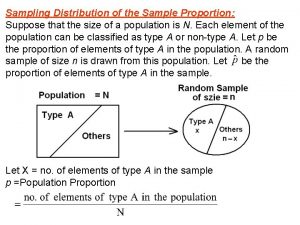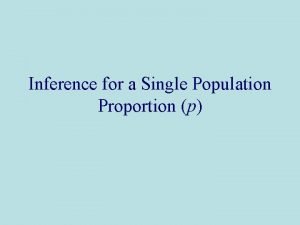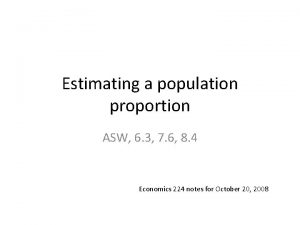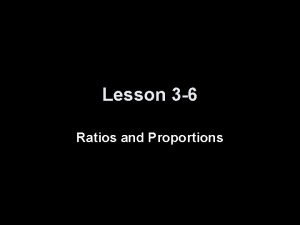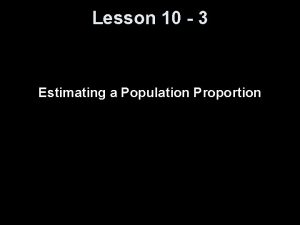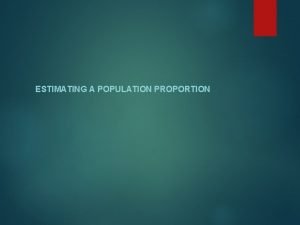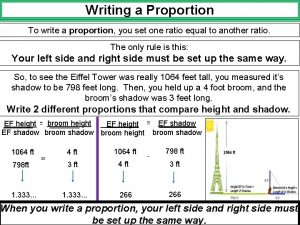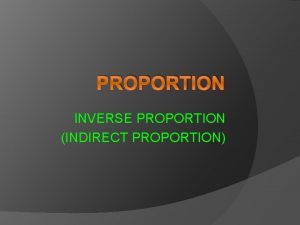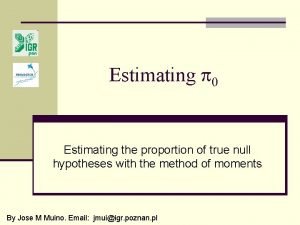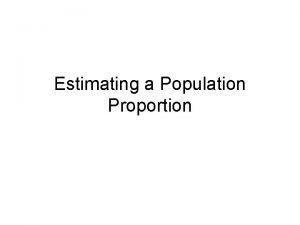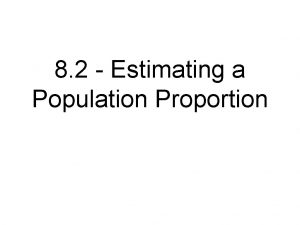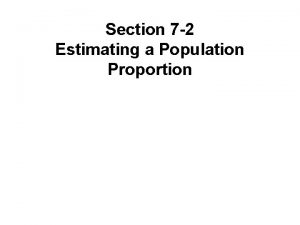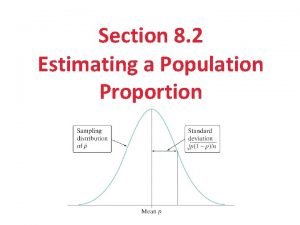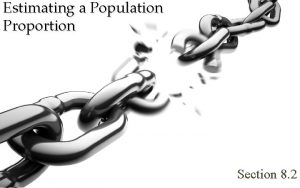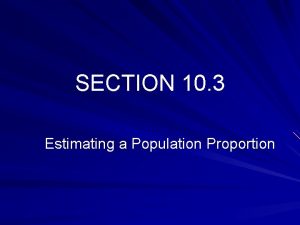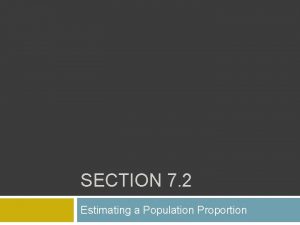Lesson 10 3 Estimating a Population Proportion Knowledge

















- Slides: 17

Lesson 10 - 3 Estimating a Population Proportion

Knowledge Objectives • List the three conditions that must be present before constructing a confidence interval for an unknown population proportion.

Construction Objectives • Given a sample proportion, p-hat, determine the standard error of p-hat • Construct a confidence interval for a population proportion, remembering to use the four-step procedure (see the Inference Toolbox, page 631) • Determine the sample size necessary to construct a level C confidence interval for a population proportion with a specified margin of error

Vocabulary • Statistics –

Proportion Review Important properties of the sampling distribution of a sample proportion p-hat • Center: The mean is p. That is, the sample proportion is an unbiased estimator of the population proportion p. • Spread: The standard deviation of p-hat is √p(1 -p)/n, provided that the population is at least 10 times as large as the sample. • Shape: If the sample size is large enough that both np and n(1 -p) are at least 10, the distribution of p-hat is approximately Normal.

Sampling Distribution of p-hat Approximately Normal if np ≥ 10 and n(1 -p)≥ 10

Inference Conditions for a Proportion • SRS – the data are from an SRS from the population of interest • Normality – for a confidence interval, n is large enough so that np and n(1 -p) are at least 10 or more • Independence – individual observations are independent and when sampling without replacement, N > 10 n

Confidence Interval for P-hat • Always in form of PE MOE where MOE is confidence factor standard error of the estimate SE = √p(1 -p)/n and confidence factor is a z* value

Example 1 The Harvard School of Public Health did a survey of 10. 904 US college students and drinking habits. The researchers defined “frequent binge drinking” as having 5 or more drinks in a row three or more times in the past two weeks. According to this definition, 2486 students were classified as frequent binge drinkers. Based on these data, construct a 99% CI for the proportion p of all college students who admit to frequent binge drinking. Parameter: p-hat PE ± MOE p-hat = 2486 / 10904 = 0. 228

Example 1 cont Conditions: 1) SRS 2) Normality 3) Independence shaky np = 2486>10 way more than n(1 -p)=8418>10 110, 000 students Calculations: p-hat ± 0. 228 ± z* SE z* √p(1 -p)/n (2. 576) √(0. 228) (0. 772)/ 10904 0. 010 LB = 0. 218 < μ < 0. 238 = UB Interpretation: We are 99% confident that the true proportion of college undergraduates who engage in frequent binge drinking lies between 21. 8 and 23. 8 %.

Example 2 We polled n = 500 voters and when asked about a ballot question, 47% of them were in favor. Obtain a 99% confidence interval for the population proportion in favor of this ballot question (α = 0. 005) Parameter: p-hat PE ± MOE Conditions: 1) SRS 2) Normality 3) Independence assumed np = 235>10 way more than n(1 -p)=265>10 5, 000 voters

Example 2 cont We polled n = 500 voters and when asked about a ballot question, 47% of them were in favor. Obtain a 99% confidence interval for the population proportion in favor of this ballot question (α = 0. 005) Calculations: p-hat ± z* SE p-hat ± z* √p(1 -p)/n 0. 47 ± (2. 576) √(0. 47) (0. 53)/ 500 0. 47 ± 0. 05748 0. 41252 < p < 0. 52748 Interpretation: We are 99% confident that the true proportion of voters who favor the ballot question lies between 41. 3 and 52. 7 %.

Sample Size Needed for Estimating the Population Proportion p The sample size required to obtain a (1 – α) * 100% confidence interval for p with a margin of error E is given by z* 2 n = p(1 - p) -----E rounded up to the next integer, where p is a prior estimate of p. If a prior estimate of p is unavailable, the sample required is z* n = 0. 25 -----E 2 rounded up to the next integer. The margin of error should always be expressed as a decimal when using either of these formulas

Example 3 In our previous polling example, how many people need to be polled so that we are within 1 percentage point with 99% confidence? Since we do not have a previous estimate, we use p = 0. 5 z* n = 0. 25 -----E Z* = Z. 995 = 2. 575 MOE = 0. 01 2. 575 n = 0. 25 -------0. 01 2 2 = 16, 577

Quick Review • All confidence intervals (CI) looked at so far have been in form of Point Estimate (PE) ± Margin of Error (MOE) • PEs have been x-bar for μ and p-hat for p • MOEs have been in form of CL ● ‘σx-bar or p-hat’ Note: CL is Confidence Level • If σ is known we use it and Z 1 -α/2 for CL • If σ is not known we use s to estimate σ and tα/2 for CL • We use Z 1 -α/2 for CL when dealing with p-hat

Confidence Intervals • Form: – – Point Estimate (PE) Margin of Error (MOE) PE is an unbiased estimator of the population parameter MOE is confidence level standard error (SE) of the estimator SE is in the form of standard deviation / √sample size • Specifics: MOE C-level Standard Error Parameter PE Number needed μ, with σ known x-bar z* σ / √n n = [z*σ/MOE]² μ, with σ unknown x-bar t* s / √n n = [z*σ/MOE]² p p-hat z* √p(1 -p)/n n = p(1 -p) [z*/MOE]² n = 0. 25[z*/MOE]²

Summary and Homework • Summary • Homework – Problems 10. 45, 46, 51, 52, 63, 64
 Example of a proportion
Example of a proportion What is proportional allocation
What is proportional allocation Sampling distribution of p hat
Sampling distribution of p hat What is the sample statistic
What is the sample statistic Point estimation
Point estimation Hypothesis testing for population proportion
Hypothesis testing for population proportion Population proportion definition
Population proportion definition Statistics for business and economics chapter 6 solutions
Statistics for business and economics chapter 6 solutions Section
Section What is a sample proportion
What is a sample proportion Population proportion
Population proportion What is the population proportion
What is the population proportion Chapter 4 population ecology section 1 population dynamics
Chapter 4 population ecology section 1 population dynamics Section 1 population dynamics answer key
Section 1 population dynamics answer key Population ecology section 1 population dynamics
Population ecology section 1 population dynamics Study guide chapter 4 section 1 population dynamics
Study guide chapter 4 section 1 population dynamics Lesson 3 working with ratios and proportion
Lesson 3 working with ratios and proportion Shared and personal knowledge
Shared and personal knowledge
